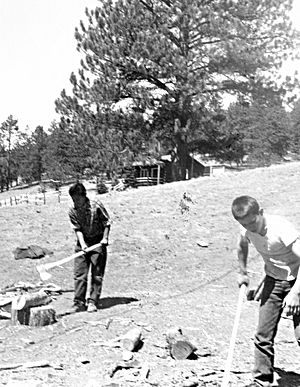Physical change facts for kids
Physical changes happen when something changes how it looks or feels, but it's still the same material deep down. Think of it like bending a paperclip – it changes shape, but it's still a paperclip. The chemical makeup of the substance doesn't change.
You can use physical changes to separate mixtures. For example, you can pick out different types of candy from a bag. But you usually can't break down a single type of candy into its basic ingredients using just physical changes. That would be a chemical change.
A physical change is different from a chemical change. In a chemical change, the substance itself transforms into something new. For instance, burning wood turns it into ash and smoke, which are new substances. With physical changes, the substance remains the same.
Most physical changes can be undone. For example, if you dissolve salt in water, you can get the salt back by letting the water evaporate.
Physical changes involve changes in things you can observe, like how something looks or feels. These are called physical properties. Examples include:
- Melting or freezing
- Turning into a gas
- Changes in strength or hardness
- Changes in shape or size
- Changes in color or texture
- Changes in how dense something is
For example, when a blacksmith makes a knife blade from steel, they heat and hammer the steel. This changes how hard the steel is, how flexible it is, and how well it can hold a sharp edge. But it's still steel.
Even though the substance stays the same, its tiny parts (atoms) might rearrange. This happens when crystals form. Most physical changes can be reversed, like melting ice and then freezing it again. Chemical changes are often harder to undo. Sometimes, a physical change might look like a chemical change, with smells or color changes. But it's still physical if the substance itself doesn't change.
Contents
What are some examples of physical changes?
Heating and cooling
Many materials change from solids to liquids and from liquids to gases when they get hot. They do the opposite when they cool down. Think about ice melting into water, and water boiling into steam.
Some materials, like iodine and carbon dioxide (dry ice), go straight from a solid to a gas. This process is called sublimation.
Magnetism
Some materials, like iron, can become magnetic. You can make them magnetic and then un-magnetize them. This process doesn't change what the material is made of.
Crystallization
Many elements and compounds can form crystals. For example, carbon can form different crystal shapes, like diamonds or graphite (what's in your pencil).
In metals, the type, shape, and size of crystals affect how strong or bendy the metal is. You can change these crystals by hammering, rolling, or heating the metal.
Mixtures
When you mix substances that don't dissolve in each other, you can often separate them easily. For example, you can use a sieve to separate sand from pebbles.
However, mixtures can sometimes act differently than their individual parts. Think about making sandcastles. Neither sand nor water alone can make a castle. But when you mix them, the water's surface tension helps the sand stick together.
Solutions
Many solutions, like salt dissolved in water, can be separated by letting the water evaporate. Other mixtures, like different types of alcohol, can be separated by heating them up and collecting the different liquids as they boil at different temperatures. This is called fractional distillation.
Alloys
When different metals are mixed together, it's called alloying. Brass is an alloy made from copper and zinc. Making an alloy is a physical change. However, separating the metals from an alloy can be tricky and might need chemical processes.
One exception is alloys where mercury is one of the metals. You can sometimes separate these by melting the alloy and boiling the mercury away as a vapor.
Images for kids
See also
 In Spanish: Cambio físico para niños
In Spanish: Cambio físico para niños





